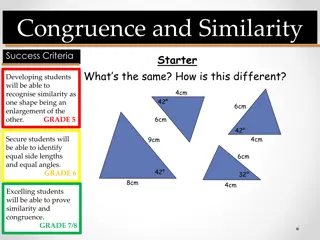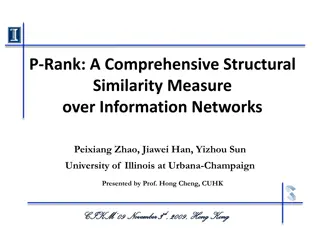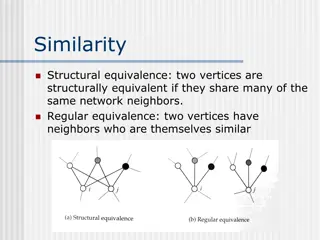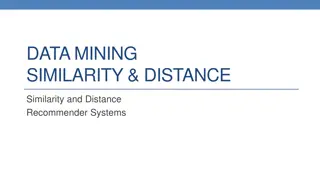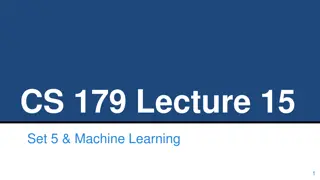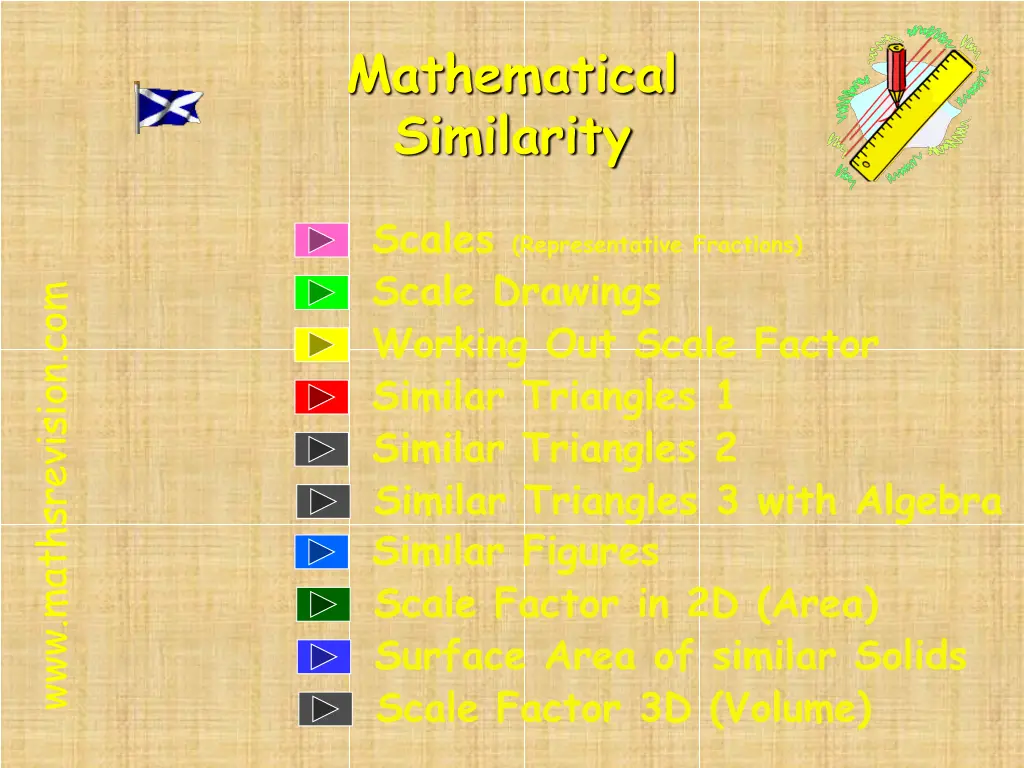
Understanding Mathematical Similarity in Geometry
Explore the concept of mathematical similarity in geometry, covering scales, scale drawings, scale factors, and working with similar triangles. Learn how to determine scale factor using representative fractions and apply it to solve problems. Understand the conditions for similarity in shapes and how to find the scale factor of enlargement between similar objects. Dive into examples illustrating the calculations of scale factors in different scenarios.
Download Presentation

Please find below an Image/Link to download the presentation.
The content on the website is provided AS IS for your information and personal use only. It may not be sold, licensed, or shared on other websites without obtaining consent from the author. If you encounter any issues during the download, it is possible that the publisher has removed the file from their server.
You are allowed to download the files provided on this website for personal or commercial use, subject to the condition that they are used lawfully. All files are the property of their respective owners.
The content on the website is provided AS IS for your information and personal use only. It may not be sold, licensed, or shared on other websites without obtaining consent from the author.
E N D
Presentation Transcript
Mathematical Similarity Scales (Representative Fractions) Scale Drawings Working Out Scale Factor Similar Triangles 1 Similar Triangles 2 Similar Triangles 3 with Algebra www.mathsrevision.com Similar Figures Scale Factor in 2D (Area) Surface Area of similar Solids Scale Factor 3D (Volume)
Working out Scale Factor Give one distance from the map and the corresponding actual distance we can work out the scale of the map. Example : The map distance from Ben Nevis to Ben Doran is 2cm. The real-life distance is 50km. What is the scale of the map. Map 2 1 1 Real Distance 50km 50 2 = 25km 250 000 : Scale Factor
Working out Scale Factor Example : The actual length of a Olympic size swimming pool is 50m. On the architect s plan it is 10cm. What is the scale of the plan. Plan 10 1 1 Real Distance 50m 5 500 : Scale Factor
Similar Triangles 1 Learning Intention Success Criteria 1. To explain how the scale factor applies to similar triangles. 1. Understand how the scale factor applies to similar triangles. 2. Solve problems using scale factor.
Conditions for similarity Two shapes are similar only when: Corresponding sides are in proportion and Corresponding angles are equal All rectangles are not similar to one another since only condition 2 is true.
If two objects are similar then one is an enlargement of the other The rectangles below are similar: Find the scale factor of enlargement that maps A to B 8 cm Not to scale! A 5 cm 16 cm Scale factor = x2 Note that B to A would be x B 10 cm
If two objects are similar then one is an enlargement of the other The rectangles below are similar: Find the scale factor of enlargement that maps A to B 8 cm Not to scale! A 5 cm 12 cm Scale factor = x1 Note that B to A would be x 2/3 B 7 cm
If we are told that two objects are similar and we can find the scale factor of enlargement then we can calculate the value of an unknown side. 13 cm The 3 rectangles are similar. Find the unknown sides x cm Not to scale! 3 cm y cm C B 24 cm A 8 cm Comparing corresponding sides in A and B: 24/8 = 3 so x = 3 x 3 = 9 cm Comparing corresponding sides in A and C: 13 /3 = 4 so y = 4 x 8 = 36 cm
If we are told that two objects are similar and we can find the scale factor of enlargement then we can calculate the value of an unknown side. y cm The 3 rectangles are similar. Find the unknown sides 7.14 cm Not to scale! 2.1 cm 26.88 cm C B x cm A 5.6 cm Comparing corresponding sides in A and B: 7.14/2.1 = 3.4 so x = 3.4 x 5.6 = 19.04 cm Comparing corresponding sides in A and C: 26.88/5.6 = 4.8 so y = 4.8 x 2.1 = 10.08 cm
Similar Triangles Similar triangles are important in mathematics and their application can be used to solve a wide variety of problems. The two conditions for similarity between shapes as we have seen earlier are: Corresponding sides are in proportion and Corresponding angles are equal Triangles are the exception to this rule. only the second condition is needed Two triangles are similar if their Corresponding angles are equal
These two triangles are similar since they are equiangular. 65o 70o 45o 70o 45o 50o 50o 55o 75o These two triangles are similar since they are equiangular. If 2 triangles have 2 angles the same then they must be equiangular = 180 125 = 55
Scale factors Enlargement Scale factor? 3 2 ESF = = 8cm 8 8 12cm 12 12 Reduction Scale factor? 2 3 5cm = RSF = 7.5cm Can you see the relationship between the two scale factors?
Scale factors Find a given ESF = 3 a 9 ESF = 3 = 9cm a 27cm By finding the RSF Find the value of b. b 5cm 1 3 b 15 5 15 RSF = = = 15cm
Finding Unknown sides (1) 20 cm b c 6 cm 12 cm 18 cm Since the triangles are equiangular they are similar. So comparing corresponding sides. b= 18 12 c 12 18 = 6 20 20 12 18 x 6 18 12 x c = = 13.3 cm b = = 9 cm
Starter Questions Q1. Find the roots to 1 decimal place 1 7 x x 0 2 = Q2. A freezer is reduced by 20% to 200 in a sale. What was the original price. 3 4 1 3 Q3. Calculate 3 1
Similar Triangles 2 Learning Intention Success Criteria 1. To explain how the scale factor applies to similar triangles with algebraic terms. 1. Understand how the scale factor applies to similar triangles with algebraic terms. 2. Solve problems using scale factor that contain algebraic terms.
Determining similarity A B Triangles ABC and DEC are similar. Why? C Angle ACB = angle ECD (Vertically Opposite) Angle ABC = angle DEC (Alt angles) Angle BAC = angle EDC (Alt angles) we know that corresponding sides are in proportion D DEC E Since ABC is similar to AC DC BC EC AB DE The order of the lettering is important in order to show which pairs of sides correspond.
If BC is parallel to DE, explain why triangles ABC and ADE are similar A Angle BAC = angle DAE (common to both triangles) Angle ABC = angle ADE (corresponding angles between parallels) Angle ACB = angle AED (corresponding angles between parallels) B C E D A line drawn parallel to any side of a triangle produces 2 similar triangles. A A B B E D E D C C Triangles DBC and DAE are similar Triangles EBC and EAD are similar
The two triangles below are similar: Find the distance y. C B 20 cm y A E D 5 cm 45 cm AE 5 y RSF = = = AD 5x20 50 20 = 2 cm y = 50
The two triangles below are similar: Find the distance y. C Alternate approach to the same problem B 20 cm y A E D 5 cm 45 cm AD 50 20 ESF = = = AE 5x20 5 y = 2 cm y = 50
In the diagram below BE is parallel to CD and all measurements are as shown. (a) Calculate the length CD (b) Calculate the perimeter of the Trapezium EBCD A A 6 m 4.5 m 10 m 7.5 cm E 4 m B 4.8 m 3 cm D C 8 cm C D 8 cm 10 CD 10 AC So perimeter = 3 + 8 + 4 + 4.8 = 19.8 cm = ( ) SF=6 a = ( ) SF=6 b 4.8 4.5 6 6 4.8 10 4.5 10 = = CD 8 cm = = AC 7.5 cm
Similar Triangles 3 Learning Intention Success Criteria 1. To explain how the scale factor applies to similar triangles with harder algebraic terms. 1. Understand how the scale factor applies to similar triangles with harder algebraic terms. 2. Solve problems using scale factor that contain harder algebraic terms.
In a pair of similar triangles the ratio of the corresponding sides is constant, always producing the same enlargement or reduction. Find the values of x given that the triangles are similar. A Corresponding sides are in proportion AB = EB 3 m AC 3 DC 4 B E x 1.5 4 m = 3 + x 3x6 18 4x x 6 C D = = = = 4(3 + x) 12 + 4x 6 1.5 6 m
In a pair of similar triangles the ratio of the corresponding sides is constant, always producing the same enlargement or reduction. Find the values of x given that the triangles are similar. Corresponding sides are in proportion PQ = T PR Q x 11.25 ST 3 PT 18 - x R 3 = 5 3x 3x 8x x 5 18 = = = = 5(18 - x) 90 - 5x 90 11.25 P S x
Similar Figures Learning Intention Success Criteria 1. To explain how the scale factor applies to other similar figures. 1. Understand how the scale factor applies to other similar figures. 2. Solve problems using scale factor.
Scale Factor applies to ANY SHAPES that are mathematically similar. 1.4 cm 7 cm 2cm y z 3 cm 15 cm 6 cm Given the shapes are similar, find the values y and z ? 15 1 Scale factor = ESF = 3 = 5 Scale factor = RSF = 5 = 0.2 y is 2 x 5 = 10 z is 6 x 0.2 = 1.2
Scale Factor applies to ANY SHAPES that are mathematically similar. a b 4 cm 7.5 cm 3 cm 8 cm 2cm 10 cm Given the shapes are similar, find the values a and b ? 4 10 Scale factor = RSF = 10 = 0.4 Scale factor = ESF = 4 = 2.5 a is 8 x 0.4 = 3.2 b is 2 x 2.5 = 5
Area of Similar Shape Learning Intention Success Criteria 1. To explain how the scale factor applies to area. 1. Understand how the scale factor applies to area. 2. Solve area problems using scale factor.
Area of Similar Shape Draw an area with sides 2 units long. Draw an area with sides 4 units long. www.mathsrevision.com 2 4 y 2 y x Area = 2 x 2 = 4 4 Area = 4 x 4 = 16 x It should be quite clear that second area is four times the first. The scaling factor in 2D (AREA) is (SF)2. For this example we have this case SF = 2 (2)2 = 4.
Another example of similar area ? Work out the area of each shape and try to link AREA and SCALE FACTOR Connection ? 2cm 6cm 4cm 12cm Small Area = 4 x 2 = 8cm2 Large Area = 12 x 6 = 72cm2 12= 3 Scale factor = ESF = 4 Large Area = (3)2x 8 = 9 x 8 = 72cm2
Example The following two shapes are said to be similar. If the smaller shape has an area of 42cm2. Calculate the area of the larger shape. 3cm Working 4cm 4 ESF =3 So area S.F = 2 4 3 16 2 4 X 42 = 9 X42 = 74.67cm2 Area of 2nd shape = 3
Questions 1. 2.
3. 4.
Surface Area of Similar Solids Learning Intention Success Criteria 1. To explain how the scale factor applies to surface area. 1. Understand how the scale factor applies to surface area. 2. Solve surface area problems using scale factor.
The same rule applies when dealing with Surface Area Example : Work out the surface area of the larger cuboid. 3cm 2cm 4cm 12cm Surface Area of small cuboid : 2(2x3) + 2(4x3) + 2(2x4) = 52cm2 12= 3 ESF = Surface Area of large cuboid : 4 (3)2 x 52 = 468 cm2
Volumes of Similar Solids Learning Intention Success Criteria 1. To explain how the scale factor applies to volume. 1. Understand how the scale factor applies to 3D volume. 2. Solve volume problems using scale factor.
Volumes of Similar Solids Draw a cube with sides 2 units long. Draw a cube with sides 4 units long. 2 2 y z 2 x 4 Volume = 2 x 2 x 2 = 8 y z 4 4 x Volume = 4 x 4 x 4 = 64 4 Scale factor = Using our knowledge from AREA section, (SF)2. For VOLUME the scale factor is (SF)3 = (2)3 = 8 ESF = 2 = 2
Another example of similar volumes ? Work out the volume of each shape and try to link volume and scale factor 4cm Connection ? 2cm 2cm 4cm 3cm 6cm V = 3 x 2 x 2 = 12cm3 V = 6 x 4 x 4 = 96cm3 6 Scale factor = ESF = 3 = 2 Large Volume = (2)3x 12 = 8 x 12 = 96cm3
Given that the two boxes are similar, calculate the volume of the large box if the small box has a volume of 15ml 2cm 6cm 6 ESF = = 3 2 33 So volume of large box = = 405 ml = 15
Example 30= 3 ESF = 20 2 ( ) 2 3 27 8 0.8 So volume of large jug = = = 2.7 litres 0.8 3
(a) SD : B = 4 : 3 SD : M = 8 : 5 3 4 ( ) 4 2 = = (b) RSF = 900cm2 Area 1600 3 B 5 6 B M ( ) 6 3 = = 1562.5cm3 (c) RSF = = Volume 2700 5 B
= 3 2 12 8 ESF = ( ) 2 3 27 8 40 40 = 1.35 So volume of large jug = = 3
= 10 10 1 (SF )3 = SF = 2.1544 2 2.1544 So surface area ratio = (SF)2 = = 4.64 Ratio of their surface area is 1 : 4.6 (to 1 d.p.)



